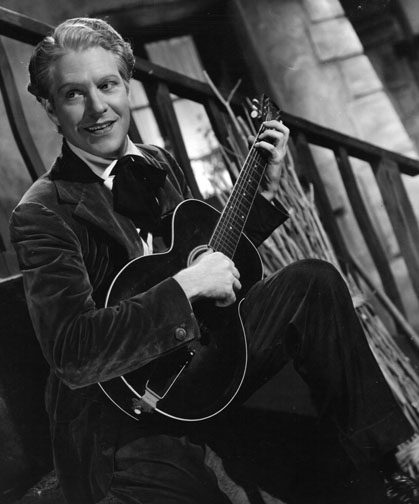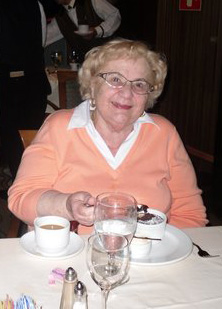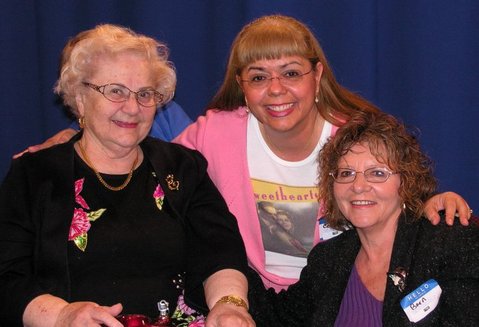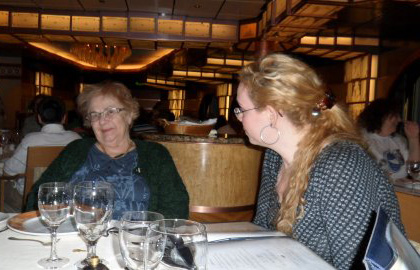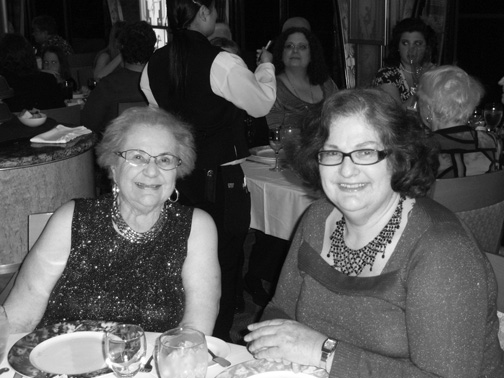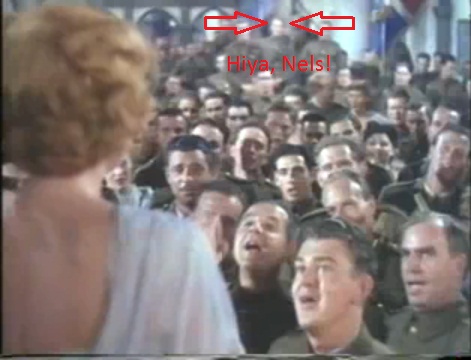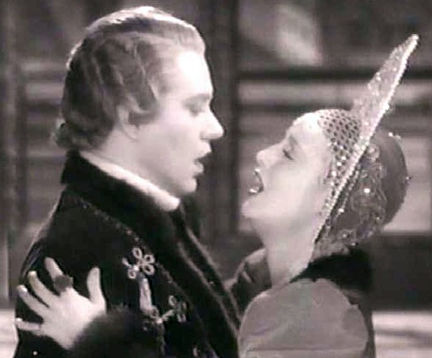
We have many requests for the lyrics for the wonderful climactic operatic scene, “Czaritza”, in the movie Maytime.
One of our club members, Ollie Mutter, was gracious enough in 2004 transcribe both the actual French lyrics and the English translation.
French:
Czarina:
Mon coeur ne pleure point
La mort du noble Czar
Qui avait [cess`e?] sans amour
Dieu, me pardonne!
Que l`assassin recoive la vie eternelle
Toi, son epouse impenitente
Tu as ton ame
As-tu trahi ton Czar!
Grusha:
pourquoi pleure la juste mort d`un tyrant?
Czarina:
Tu as raison, c`est is tyranic Les cosaques du Czar
qui meurt.
Oh, Oh patre! Russie
Dieu te libere
Amen.
(sound of a struggle)
Czarina:
Pertov! Mon dieu C`est toi?
Dubrovsky: (Bass)
Le Czar est mort. Vive la Czarina
Chorus sings in Russian. Czarina must go
out on the balcony to acknowledge the
cheers of the crowds below.
Dubrovsky: (to czarina)
Pour l`assassin,pour le traitre,
voici l`arret a` signer.
Czarina: (to petrov)
Defends toi vite, ou tu mourras!
Dubrovsky: (To Czarina)
Vous hesitez? Signez! Au mon du Czar
Petrov:
Dieu a donne a ce monde
La liberte et l` honneur
Poru vous, je donne ma vie,
Oh, Reine au ma patrie.
Czarina:
Tu va mourir,amour si tendre.
Dubrovsky:
Alors, le chien mourra.
Czarina:
Mon coeur, aussi.
Petrov
je donne ma vie et un peuple vivra.
La viese gagne au prix dela mort.
j`entends le tambour, etj` ai fait mon devoir,
je vais mourir, mon ame est en paix.Czarina:
Oh, sombre destin, Oh, devoir cruel
D`etre condamne a mort.
Ton crime odieux nous separe,
Tu as merite ton sort.
Czarina and (Petrov as a duet)
Tu vas mouri paria main du boureau
Qui, sans pitte, a` abat et chatie
La homte suit dams la tombe
et tumeurs en vain!
Petrov: ( sings simultaneously with above duet)
Mort! Mort! La honte to suit etc,
Czarina: (to everyone present)
Laisse nous seuls,j` ai a tui parie un instant
Dubrovsky: (horrified)
Votre Majestee!
Czarina: ( reproving his lack of obedience)
Ton Czar!
Petrov:
Mon amour, te souviens tu des passes.
reves, des reves passes.
Czarina:
Sort sans pitte qui separe,
Nos coeurs au asuil meme de la mort.
Petrov:
La deliverance, La vie, commence
De tout min coeur a jamais, je t`adore.
Mon ame, s`enivre. Tu me delivres.
Czarina:
Biens ame, mon amour t`appararaitras.
Petrov:
Quittez un etre si cher.
Czarina:
Et ton courage me soutient.
Petrov:
Ou dans is siel ou L` enfer-
Both:Je t`aime.
Czarina:
Joie dans mon coeur! L`extase me dit assez.
Je n` aime au monde que toi.
C`est l` amour qui jamais ne renounce
Petrov:
Seul l` amour endure, seul l’amour endure
Porr toujours, Oh, mon ame chantait,
embrasse moi mon ame chantait,
un chant divin, divin dans tes bras.
(again a duet)
Czarina:
Mon ame chantait, chantait.
Petrov:
Je vis bien aime, mon amour, viens.
Czarina:
Dans te bras,
je vis bien aime, mon amour, viens.
Viens, douce mort! amour vivra,
au dela de la mort,
L` amour invincible.
Seigneur, protege nous.
Dieu aies pitie de lui.
Petrov:
Seigneur, a genoux, ales pitie de moi.
Dieu, te benisse, Le seigneur protege mon amour.
Czarina:
Dieu, recevez l`ame de monbien amie.
Ecoutaez ma priere, Dieu, te protege mon amour.
Adieu, Adieu
Petrov (as he is dragged off)
Le Seigneur protege mon amour du mal. Portege la,
Je vais mourir, Dieu te protege mon amour.
Adieu, Adieu.
English:
My heart is unable to cry,
To mourn the death of the noble Czar
Who has [departed?] without my love.
God forgive me!
May his assassin be rewarded with eternal life.
But I, his unrepenting wife,
My immortal soul is in danger.
did I betray my Czar?
Grusha:
Why should you cry over the death of a tyrant?
Czarina:
You’re right. Tyranny died, not the Czar.
Oh my country, my Russia.
God has freed you.
Amen.
(sound of a struggle)
Petrov is dragged in.
Czarina:
Petrov! Dear God ! It’s you!
Dubrovsky:
The Czar is dead, Long live the Czarina.
chorus sings in Russian. Czarina must go out
on the balcony to acknowledge the cheers of
of the crowds below.
Dubrovsky: (to Czarina)
Here is the traitor’s arrest warrant for you to sign.
Czarina (to Petrov)
Quickly defend yourself, or you will die!
Dubrovsky: ( to Czarina)
You hesitate? Sign in the name of the Czar!
Petrov:
God has given the world
Liberty and honor.
(to Czarina) To you I give my life,
Oh, Queen of my dear country.
Czarina:
You will surely die, dearly beloved.
Dubrovsky:
Yes! this villain [dog] must die!
Czarina:
My heart, too, will die.
Petrov:
I am giving my life so the people may live
My life has earned the ultimate reward of my death.
I hear the drums [ as at a hanging] My duty is done.
I’m going to die. My soul is at peace.
Czarina:
Oh, dark destiny, Oh cruel sacrifice,
To be condemned to death.
Your terrible crime will separate us.
Yet you have earned your fate.
(duet next two stanzas)
Czarina:
You will be executed by the state
Which pitilessly cuts down and punishes the guilty.
This shame will follow you to the grave.
You die for nothing!
Petrov: (sings simultaneously with above)
Death! Death! This shame will not follow me the grave. I do not die for nothing.
Czarina: ( to everyone present)
Leave us alone. I want to speak with him for a moment.
Dubrovsky ( horrified)
Your Majesty!
Czarina: (reproving his lack of obedience)
(Yes, indeed, I am now) your Czar!
Petrov:
My love, I recall such beautiful dreams of long ago.
Czarina:
You have no pity if you would leave me like this.
My heart is also on the threshold of death.
Petrov:
This is life, not death, Life is just beginning
More than ever, I adore you.
My soul is exalted. You have liberated me.
Czarina:
Dearest soul, you can see how much i love you.
Petrov:
To leave someone so precious to me.
Czarina:
Your courage will sustain me.
Petrov:
Whether I am in Heaven or Hell–
I love you.
Czarina:
My heart is bursting with joy.
This ecstasy is enough for me.
I love no one on earth but you.
A love I can never lose.
Petrov:
Only love endures, only love endures
Forever, Oh my soul is singing.
A song divine, divine in your embrace.
( again a duet)
Petrov:
I live and love, come, my love.
Czarina:
In your embrace,
I live and love, come my love.
Come, sweet death! Love lives in death.
Invincible love,
Dear Lord, protect us.
Dear Lord, have pity on us.
Petrov:
Dear Lord, on my knees,
I beg you to have pity on us.
Dear Lord, forgive me, Protect our love.
Czarina:
Dear Lord, receive the soul of my dearest love.
Hear my prayer, dear Lord, protect my love.
Goodbye, Goodbye.
Petrov ( as he is dragged off)
Dear Lord, protect my dearest love from harm,
Protect her, I’m going to die, Lord, protect my love.
Goodbye goodbye….
(…then czarina faints in the arms of Grusha as the curtain descends.)
